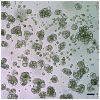Patient-derived models of human breast cancer: protocols for in vitro and in vivo applications in tumor biology and translational medicine
- PMID: 23456611
- PMCID: PMC3630511
- DOI: 10.1002/0471141755.ph1423s60
Patient-derived models of human breast cancer: protocols for in vitro and in vivo applications in tumor biology and translational medicine
Abstract
Research models that replicate the diverse genetic and molecular landscape of breast cancer are critical for developing the next-generation therapeutic entities that can target specific cancer subtypes. Patient-derived tumorgrafts, generated by transplanting primary human tumor samples into immune-compromised mice, are a valuable method to model the clinical diversity of breast cancer in mice, and are a potential resource in personalized medicine. Primary tumorgrafts also enable in vivo testing of therapeutics and make possible the use of patient cancer tissue for in vitro screens. Described in this unit are a variety of protocols including tissue collection, biospecimen tracking, tissue processing, transplantation, and three-dimensional culturing of xenografted tissue, which enable use of bona fide uncultured human tissue in designing and validating cancer therapies.
Curr. Protoc. Pharmacol. 60:14.23.1-14.23.43. © 2013 by John Wiley & Sons, Inc.
Figures






References
-
- Caligiuri I, Rizzolio F, Boffo S, Giordano A, Toffoli G. Critical choices for modeling breast cancer in transgenic mouse models. J. Cell. Physiol. 2012;227:2988–2991. - PubMed
-
- Cespedes MV, Casanova I, Parreno M, Mangues R. Mouse models in oncogenesis and cancer therapy. Clin. Transl. Oncol. 2006;8:318–329. - PubMed
Publication types
MeSH terms
Grants and funding
LinkOut - more resources
Full Text Sources
Other Literature Sources
Medical
Research Materials

